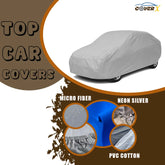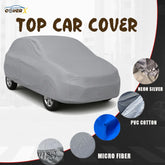The Waterproof Myth: Why Most Car Covers Fail in Pakistan’s Climate
It’s a familiar story for car owners across Pakistan. You buy a new “100 % waterproof” cover before monsoon season, confident that your vehicle will stay dry. Yet a few weeks later, you peel it off to find beaded moisture on the paint, a faint musty smell, and small rust spots forming around the edges. The very protection you paid for has created new problems.
This recurring disappointment isn’t bad luck it’s simple physics and a misunderstanding of how materials behave in our climate.
Why “Waterproof” Covers Fail
1. They Trap Moisture
Thick plastic or PVC sheets do an excellent job of keeping rain off, but they also seal in whatever dampness your car already has. After washing your car or parking it on a humid evening, that moisture turns into vapor. When the temperature drops overnight, it condenses on the metal surface almost like a mini greenhouse forming under the cover.
2. They Encourage Mold and Mildew
That trapped damp air has nowhere to go. Inside the sealed cover it stays warm and dark, which is exactly what fungus loves. A faint white haze soon develops on the car’s surface and the inner side of the cover. Within weeks, mildew stains appear that can permanently mark rubber trims and paint edges.
3. They Damage Paint and Clear Coat
Every cycle of condensation eats away at the car’s finish a little more. The constant dampness dulls the clear coat, and microscopic rust spots start working their way through the paint layers. By mid‑season, the so‑called “protection” has quietly done more harm than the weather outside.
Why Breathability Matters in Pakistan
Pakistan’s weather punishes cars in every possible way. Lahore and Rawalpindi deal with fog and humidity, Karachi faces intense sun mixed with salt air, and Multan and Faisalabad suffer from dry heat and blowing dust. A single‑layer waterproof sheet simply can’t handle all of that.
A breathable multi‑layer cover, especially one made from microfiber, adapts to these extremes. The fabric allows heat and vapor to escape while keeping out rain, dust, and UV rays. This airflow prevents condensation from forming and creates a small protective air cushion that keeps paint cool and dry.
Unlike PVC or parachute materials, microfiber doesn’t bake under sunlight or stiffen after a few months. Its fine, non‑woven fibers continue to breathe long after the season changes, which makes it ideal for year‑round use from monsoon to midsummer heat.
What to Look for When You Buy
- Look for multi‑layer fabric construction that balances protection and airflow.
- Make sure there’s a soft inner lining to prevent swirl marks if light dust remains on the surface.
- Check for a UV‑reflective outer layer to protect the color and dashboard from heat.
- Go for a custom fit with straps or elastic hems so wind can’t lift or scratch it.
The promise of a waterproof car cover sounds reassuring, but in Pakistan’s mixed climate it often does more harm than good. The smarter, long‑lasting choice is a microfiber cover one that resists rain, reflects sunlight, and still breathes enough to let hidden moisture escape.
If your goal is to preserve paint shine and prevent rust, choose a breathable, water‑resistant microfiber design and let your car stay dry the right way. It’s a small decision that makes a big difference every time the weather turns.






